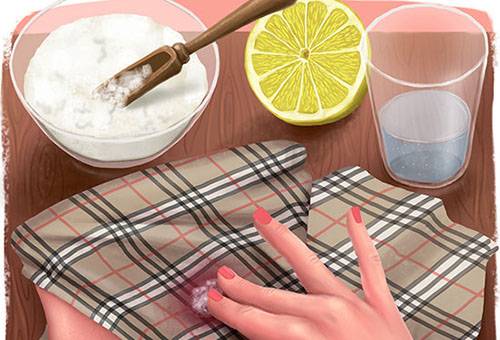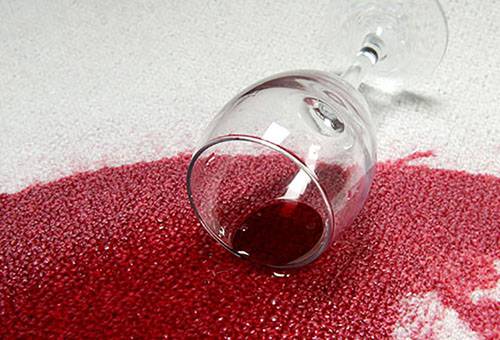How to remove stains from fruits and berries from clothes and other surfaces?
Sooner or later, every housewife asks the question of how to remove fruit stains, especially if there are active and not very neat little children in the house. Traces of fruit juice are not a reason to throw away your clothes or recycle them. Even heavy stains can be removed from the fabric without leaving a trace, without damaging it.

Removing fruit stains from clothes
The “older” the stain, the deeper it eats into the structure of the fabric and the more difficult it is to remove, so it is better to wash clothes using fresh stains.
Fresh spots
With fresh stains, you can even do without any detergents - they are easily removed with ordinary boiling water, which must be poured until the stain turns pale and disappears.
Another excellent remedy that is guaranteed to be on hand for almost any housewife is table vinegar. It removes not only fresh traces of fruit, but also quite old and ingrained ones. How to use it? Moisten a cotton swab or pad and wipe the stain.
A simple but effective remedy for recent stains is a solution of soda (a teaspoon per glass of water).
Everyone knows that greasy stains are sprinkled with salt so that it absorbs most of the fat. The same is true for berry marks. Therefore, if it is not possible to wash the item right away, then salt will help make washing easier in the future.
After the dry salt has absorbed some of the fruit juice, you need to carefully shake it off, and put a slurry of wet salt on the stain and leave it until you can wash the item in the usual way.
How to remove old stains
- A solution of citric acid, taken in the proportion of a teaspoon to one glass of water, works well with old traces of berries. Instead of citric acid, oxalic acid is also used. If you don’t have any acid on hand, you can do it even simpler and squeeze a little lemon juice onto the stain or even put a piece of lemon on it.
- A mixture of glycerin and raw egg white, taken in equal proportions, removes traces of not only berries and fruits, but also products made from them, such as wine, and also refreshes the colors on clothes. This product must be applied to the fabric and wait until it is absorbed, and then thoroughly washed in warm water.
- If old traces of berries are found on white items made from natural materials (cotton and linen), then it is recommended to soak them in milk or curdled milk for several hours before washing. And for products made of colored fabrics, use a spoonful of ammonia and hydrogen peroxide added to a glass of water.
- Fruit juice penetrates into wool and silk quite strongly, so it is more difficult to remove it - you need to mix White Spirit with glycerin in equal proportions, moisten the stain with this mixture and leave for several hours, then wash the product.
Stain removers
Specialized stain removers are, as a rule, quite aggressive substances. Therefore, it is important to carefully read the instructions or information on the label before using them.It will definitely tell you how to use the product correctly and what fabrics it is suitable for. It’s even better if you can test this stain remover on a separate piece of the same fabric or in an inconspicuous place of clothing to be sure that trying to remove the stain will not completely ruin the item. This is especially true for multi-colored and synthetic fabrics; they often behave unpredictably.
Do not immediately use aggressive agents in concentrated concentrations to avoid damaging the fabric. It is better to use weaker solutions several times or gradually increase their concentration.
Advice
To prevent the stain remover, along with any remaining dirt, from spreading over the fabric, creating streaks around the stain, you can put a well-absorbing fabric on the inside and remove the stain from the edges to the center using circular movements.
Recommendations
- After the splashes of berry juice have been removed, it is better to wash the item in cool water with the addition of ammonia (a tablespoon per liter of water).
- Fruit stains cannot be removed with soap; it only strengthens the stain in the fibers of the fabric.
- If the stain is very small, then to prevent it from spreading over a large area of the fabric, it is better to drip the stain remover onto it from a pipette or using a brush or wooden stick.
- You can remove berry stains from woolen fabrics with glycerin diluted in warm water, after which the item must first be washed with soap and then rinsed thoroughly.
Removing traces of fruit from other surfaces
Naturally, most often stains from berries and fruits end up on clothes or kitchen utensils such as towels and tablecloths. But sometimes they also end up on floor coverings or carpets.And if the carpet can still be washed somehow, then removing the carpet from the floor for this purpose is not the best solution. Basically, there are a large number of stain removers specifically for carpets. They effectively remove stains from many products, and then simply wash the stained area with soapy water.
It is best to try to remove stains from the surface of artificial leather products (both furniture and clothing) with warm water and soap as the mildest and most non-aggressive means. And only if it was not possible to clean the item, you can try stronger substances - solvents, alcohol. But there is no guarantee that along with the stain they will not partially erase the paint from the item.
If you still haven’t been able to get rid of the stain on your item in any way, then you should think about how to hide it. If we are talking about traces of berries on the carpet, then they can be hidden under the furniture; splashes of fruit juice on the sofa will be hidden under the pillow. It is good to cover stains of fruits or berries on clothes with some decorative element - lace, brooch, applique, button, in general, anything that matches the item in color and style.




Now I always pour boiling water over berry stains. Such a simple and effective way.